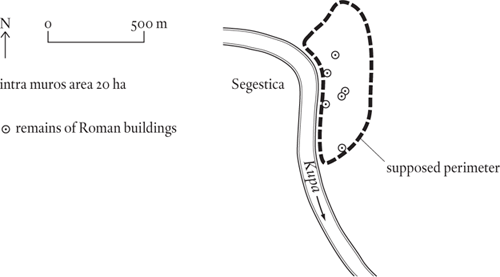
Present-day Sisak, Croatia
Capital of the late Roman province of Savia
Roman Siscia, like the modern town of Sisak that overlies it, was situated on the left bank of the River Kupa, a few kilometres above its junction with the Save. A pre-Roman settlement called Segestica lay on the opposite bank, but is not mentioned after the Roman conquest of the region in 35 BC. It had a history of resisting Roman interventions in the area, so it is likely that Octavian, the future Augustus, who was masterminding the advance to the Danube that began at this time, destroyed Segestica, replacing it with a new construction, perhaps a legionary camp, where Sisak now stands.

After Augustus and Tiberius had completed their military programme, the army units involved were gradually moved up to the Danube line. They left behind a population of discharged veterans, of which Siscia would have received its fair share – only this can explain the town’s recognition as a Roman colony by the emperor Vespasian at the very early date of AD 71. Among the towns of Pannonia – admittedly not a very impressive lot – Siscia had been singled out for special favour.
Further promotion came in the troubled times of the later third century. When the Danube frontier collapsed under barbarian attack, Siscia became an important backup for the new defence line on the Drave. In 262 the embattled emperor Gallienus established a mint in the town to ensure that the defending troops got paid; when the emperor Diocletian restored order in the region, he made Siscia the capital of Savia. This new province had been created by the division of Pannonia Superior into Pannonia Prima (the northern half) and Savia (the south). In terms of status, if nothing else, the early fourth century was to be Siscia’s high point.
The town’s decline began with a sack by the usurper Magnentius in 351. Thereafter it mirrored the fading fortunes of the Western Empire. In the late fifth century it passed under Ostrogothic control; in the sixth it was part of the Lombard domain, before finally succumbing to the Slav inundation of the seventh century.
Sisak’s town wall was mapped in the eighteenth century before being demolished in the nineteenth. Such remains of the Roman town as have been discovered lie within this circuit, which enclosed about twenty hectares, and all the cemeteries lie without, so it is a fair assumption that the same wall served the town throughout its history. On the other hand the deduction is not completely reliable, as witness SOPIANAE, and there is a distinct possibility that there is a smaller Roman circuit inside the eighteenth-century perimeter. Planned excavations are needed to decide the matter, but planned excavations are exactly what Siscia has never had; all of the finds so far are accidental, and as a result next to nothing is known about the Roman town.
The archaeologists Remza Koščvić and Rajka Makjanić think the population of Siscia was at a minimum 20,000 to 30,000, and maybe ‘much higher’. A figure somewhere around the 2,000 mark seems easier to accept.